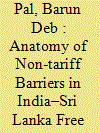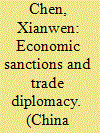| Srl | Item |
| 1 |
ID:
172217


|
|
|
|
|
| Summary/Abstract |
This article attempts to answer one crucial research question: why the utilization of India–Sri Lanka Free Trade Agreement (ISFTA) route for trade is very poor by the Indian exporters (13%) as compared to their Sri Lankan counterpart (65%) even after one decade of its implementation? The available studies have blamed the non-tariff barriers (NTBs) which are hamstringing the growth of trade between these partners development of international trade. However, these have considered NTBs as subset of non-tariff measures (NTMs) which are quite narrow sense of finding the hidden barriers within the International trade process. Therefore, this article has analysed in detail the logistic process involved in international trade between India and Sri Lanka to understand various NTBs sheltered within this logistic process. Further, the article has identified issues which are not directly beyond the logistic process which are affecting the international trade between these two countries.
|
|
|
|
|
|
|
|
|
|
|
|
|
|
|
|
| 2 |
ID:
144073


|
|
|
|
|
| Summary/Abstract |
This article confirms that China’s economic sanction in the form of restricting salmon imports from Norway was in retaliation for the 2010 Nobel Peace Prize awarded to a Chinese dissident. By combining personal accounts of stakeholders interviewed in the Norway–China salmon trade with an examination of trade data, there is strong evidence that links changes in trade patterns of fresh/chilled whole Norwegian salmon to border measures applied in response to the peace prize. While disproportionate border measures targeting Norwegian salmon have distorted China’s market since 2011, private actors appear to have busted the sanction by circumventing these measures, including rerouting, falsifying country-of-origin certification, and smuggling. This could have long-term consequences for trade patterns and quality. Official statistics record a reduced Norwegian market share and decreased Norway–China salmon trade despite an expansion of the volume of Chinese imports. However, official data do not record Norwegian salmon entering illegally, which some stakeholders estimate at between 50 and 70 per cent of the market. Norway’s official refusal to meet the Dalai Lama in May 2014 suggests that China’s sanction has affected foreign policy. The salmon sanction demonstrates that China has become more assertive in its international relations.
|
|
|
|
|
|
|
|
|
|
|
|
|
|
|
|
| 3 |
ID:
082349


|
|
|
|
|
| Publication |
2008.
|
| Summary/Abstract |
Despite the much-touted celebration of the successes of the General Agreement on Tariffs and Trade/World Trade Organization in liberalizing free trade, these successes have been limited due to the increasing use of non-tariff barriers (NTBs) as a form of 'protectionism in disguise.' Among advanced industrial economies, the use of NTBs varies considerably. The purpose of this paper is to explain what accounts for this variation. We locate the issue of international trade in its appropriate theoretical context - as a two-level game in which politicians simultaneously face pressure at the international level to fulfill commitments to international free trade agreements, and domestic pressures for protectionist relief. We conduct a statistical analysis using a simple, multivariate regression model examining data at three points in time, 1988, 1993, and1996, to highlight the causes of the rise in NTBs and variation in their usage. We hypothesize that PR-based systems are associated with lower rather than higher levels of NTBs
|
|
|
|
|
|
|
|
|
|
|
|
|
|
|
|